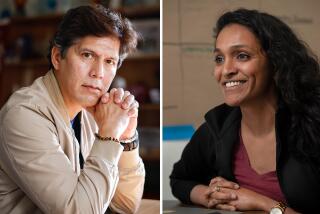Coalition starts drive to help homeless people leave MacArthur Park

Faced with a crush of homeless people as gritty downtown gives way to luxury lofts, a coalition of social service agencies on Thursday launched a push to help down-and-outers sleeping in MacArthur Park get back on their feet.
The coalition, led by City Councilman Gil Cedillo, set up blue tents near the Levitt Pavilion in the park just west of downtown, where providers will dispense medications, healthcare, mental health treatment and housing aid through the summer. By 8 a.m. Thursday, outreach workers were circulating through the park benches, handing out vouchers for nearby transient hotels.
“Homelessness is an economic problem, a social problem and most of all a moral problem,” said Cedillo, speaking in both English and Spanish. “We are rolling our sleeves up and joining this [effort] person to person.”
Ronald Armijo, 48, said he and his partner, Peggy Repreza, welcomed the help.
“When you’re in the park you just sit here and become lazy,” said Armijo, adding that the couple, homeless four months since their Glendale telemarketing employer shut down, needs alcohol abuse counseling.
Fredy Ceja, Cedillo’s spokesman, said destitute people streaming out of skid row and downtown have been setting up tent cities along the Los Angeles River, in parks and under bridges in Cedillo’s district. Cedillo said his office found 76 homeless people along MacArthur Park’s curving paths in a recent count.
The influx is on a collision course with MacArthur Park’s own, imperfect renaissance. Once the epicenter of crime in the infamous Rampart Division, the park now has hip mid-century lofts overlooking its mirror lake, and a summer concert season starting that includes British folk rock legend Richard Thompson. Repreza said a group of homeless teenagers already have been “shooed away” from the park.
The story of Armijo and Repreza, however, illustrates the difficulty of getting economically marginalized people into lasting and stable housing. Over the years, the couple has been in and out of shelters, where Armijo was jumped and lost his hearing, and transient hotels, where Repreza caught a case of scabies she can’t shake. Always they end up back on the streets, they said.
Michael Kennedy and his partner, Tanya Batups, both 52, said they’d been homeless six years on and off. Both have mental health issues -- he’s bipolar, she has post traumatic stress disorder -- and live on general relief payments too low to afford even skid-row-style hotel rents, he said.
“You get a room for two or three days, then you’re back on the streets,” said Kennedy, whose less-than-honorable discharge from the Army prevents him from receiving veteran aid.
This couple, too, got a voucher for temporary housing. Batups said she had been in various transitional housing programs aimed at getting her off the streets permanently. But they never worked out.
Ceja said the hope is that a coordinated array of services on the spot for homeless people will succeed whether other efforts have failed.
“It’s a one-stop shop -- medical, housing, medication for HIV/AIDS,” he said. “But it’s up to the individual.”
More to Read
Start your day right
Sign up for Essential California for news, features and recommendations from the L.A. Times and beyond in your inbox six days a week.
You may occasionally receive promotional content from the Los Angeles Times.







